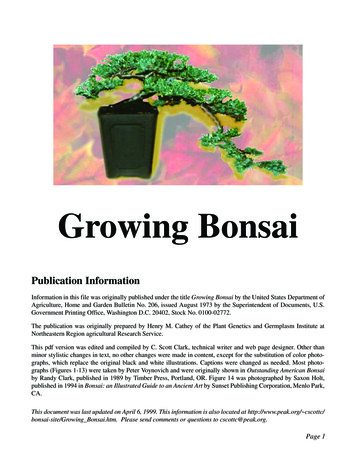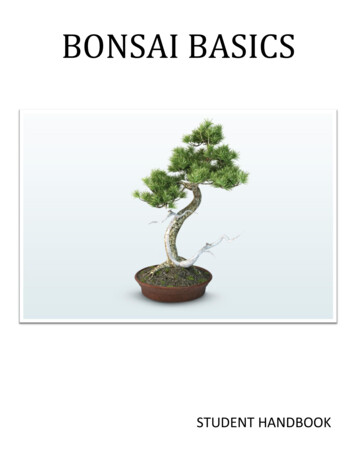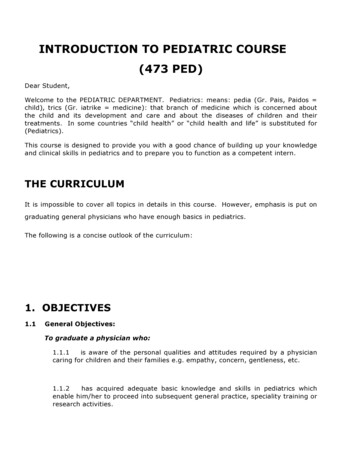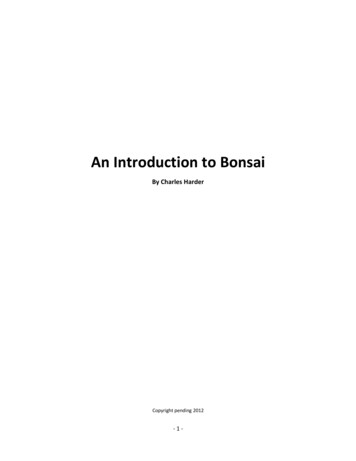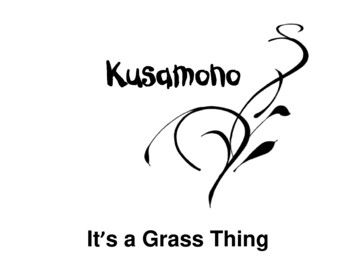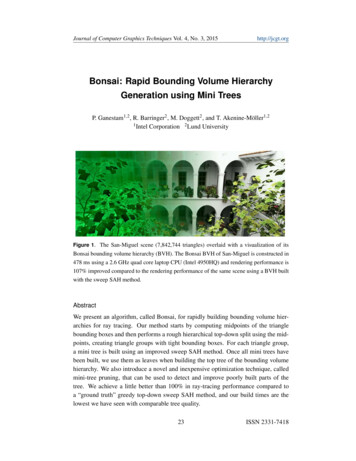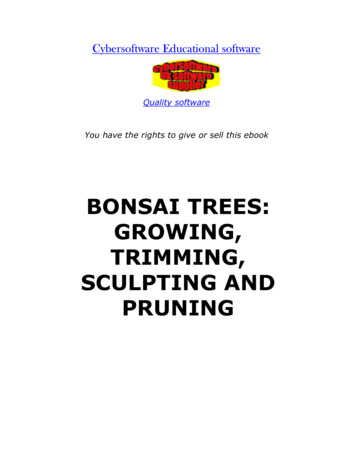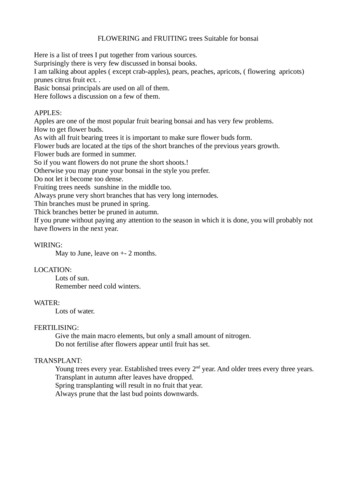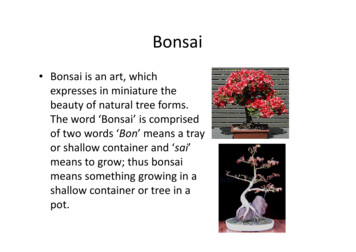
Transcription
Bonsai Bonsai is an art, whichexpresses in miniature thebeauty of natural tree forms.The word ‘Bonsai’ is comprisedof two words ‘Bon’ means a trayor shallow container and ‘sai’means to grow; thus bonsaimeans something growing in ashallow container or tree in apot.
Origin of bonsai culture China in 1133 A.D. However, Japanese claims its originators. But, reaches height of popularity by Japanese in 17thcentury. Now it is considered as a part of domestic, artistic lifeof the countrymen. There is hardly any house without a bonsai in Japan. All over the world with increase in multi-storeybuildings the use of bonsai in interior decoration hasincreased.
How bonsai making is an art ? Bonsai culture requires painter’s eye.Poet’s imagination.Sculpture’s hand.Bonsai is essentially the art of choosing a plant whichhas the potential of becoming a good bonsai. Growing it under complete, constant and affectionatecare so that it blends with the container in which it isplanted to express its natural beauty. Thus, every bonsai has its own personality andindividuality like human beings.
Bonsai garden
Successful bonsai grower Bonsai should be watched with constantattention and affection like children followingthe theory of ‘Love begets love’. A person must spare sometime daily to lookafter the bonsai.
Bonsai v/s pot plant A pot plant is usually valued for ornamentalflowers, foliage, fruits or bracts. In bonsai the beauty of entire plant along withits harmony with the container is the matterof aesthetic appreciation.
Factors affecting the success of a goodbonsai Selection of right plant species.Constant, complete and affectionate care.Suitable growing media.Adequate sunshine, water, ventilation andfertilizers. Careful trimming, training, pruning, wiring andrepotting. Balance among the roots, trunk, branches andfoliage should always be maintained.
Categories of bonsaiCategories of bonsai with respect to size (heightin inch): Mamie 2” to 6” Small6” to 12” Medium12” to 24” Large24” to 60”
Bonsai styles Formal uprightInformal uprightWind sweptSlantingSemi-cascadeFull-cascadeMultiple trunksGroup plantingRaftBroomRock-grown
Formal upright
Informal upright with Lagerstroemia indica
Japanese Maple structural style
Structural bonsai style
Azalea with structural style
Half cascade style with Gardenia
Cascade style with variegated star jasmine
Wind swept
Rock grown bonsai
Rock grown bonsai
Rock grown bonsai
Multistem vertical
Growing media for bonsai Coarse, well drained medium which providebasic needs like water, oxygen and nutrition. Equal portion of soil, leaf mould and crushedbricks or sand is ideal medium. Top layer must have sufficient humus. Conifer plants require more dry soil and fruittrees require soil with more humus.
Ideal nutrition for bonsai Sludge or well rotten cow dung slurry. Groundnut and cotton or neem cake one kgeach is mixed in five litres of water. This is allowed to rotten or ferment for abouta month before diluting another five times. A mug of this is given twice in a month. A pinch of bone meal and single superphosphate mixed is also very beneficial.
Training and pruning To develop in to a good attractive shape. Reduced growth by regular trimming andpruning also restrict growth and maintainproper balance between roots and shoots. In one trimming not more than 1/3rd portionof roots or shoots are cut.
Watering in bonsai Bonsai requires plenty of water and nutrientsto express their maximum beauty of flowersand foliage. Living in a restricted space these arecompletely dependent upon their attendantfor meeting requirement of water andnutrition. Best time for watering is morning or evening.
Selection of plants for bonsai Lot of knowledge, perseverance and experience isrequired to select a right plant. Plants with smaller flowers and fruits are selected asfoliage automatically gets reduced to about 1/4th. Plants bearing flowers on leafless branches are verygood. Plants selected must be able to grow in stressconditions of small growing medium and lownutrients.
Propagation SeedsCuttingsLayeringGraftingBuying from nurseryCollection from forests and fields.
Important plants for bonsai Amaltas, Araucaria, Babul, Bamboo, Banyan,Ber, Bottle brush, Bougainvillea, Casuarina,Cherry, Chinese orange, Coranda,Cryptomeria, Deodar, Duranta, Excoecaria,Gulmohar, Hibiscus, Ixora, Jacaranda, Java figtree, Murraya, Malpighia, Oleander, Peach,Pines, Pilkhan, Pipal, Plum, Prosopis, Silveroak, Tamarind, etc.
Important plants for bonsai in hills Araucaria, Aucuba, Azalea, Camellia, Chinesehat, Coral tree, Cryptomeria, Cypress, Flameof the forest, Ginkgo, Juniper, Koelreuteria,Maple, Magnolia, Plane tree (Chinar), Peach,Pines, Podocarpus, Sal, Silver fir, Spruce,Taxus, Thuja, Willows, Zanthoxylum, etc.
Equipments and tools for bonsai Plant Pots: square, round, oval, rectangular, heart, hexagonal oroctagonal shape with one drainage hole at the bottom. Potting mixture: soil, sand and leaf mould Potting sticks Sieves Copper wire of 10 to 22 gauze Wire cutter Pruning knife and secateur Watering can and tub Turntable
Demonstration on Juniper bonsai in Columbia
Planting time February-March July-August
Important Do’s Choose plants hardy suitable for local climatic conditions.Choose simple container with adequate drainage.Position the plant correctly in the container.Do potting and repotting at right time.Eliminate air pockets during potting and repotting.Trim or prune regularly to produce a fine network of shoots.Keep bonsai in open airy place.Give balanced nutrition and use mild fertilizers or slow releasefertilizers.Provide plenty of sunshine to all sides of bonsai.Do thorough watering until water comes out of drainage hole.Check regularly drainage as water logging is very harmful.Inspect often for insect-pests and diseases.Develop a design suitable for the species.Design must be well balanced and natural looking.Give your love and affection by proper and constant care to bonsai.
Important Don’ts Avoid choosing plants with large leaves, flowers and fruits.Do not choose a style unsuitable for the species.Avoid use of blunt cutting implements.Avoid unnatural objects for decoration.Do not be in hurry for getting flowers or fruits before gettingdesired shape.Do not mix chemicals and fertilizers in the same solution.Do not keep bonsai on the ground.Do not tie wire very tightly as it remains its dents after removal.Do not retain wires for a long duration.Avoid hard pruning in conifers.Do not give heavy fertilizers.Avoid freakish appearance of bonsai.
Bonsai is essentially the art of choosing a plant which has the potential of becoming a good bonsai. Growing it under complete, constant and affectionate care so that it blends with the container in which it is planted to express its natural beauty. Thus, every bonsai has its own personality and individuality like human beings. Bonsai garden. Successful bonsai grower Bonsai .
